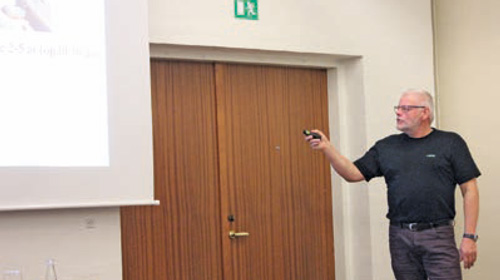Written by Torben Lindegaard Jensen
For the magazine STRAATAG for the Straatag association, No. 63, Year 16, February 2018.

On December 5, 2017, we held a very successful evening event at Odder Parkhotel. The event differed from our normal events and excursions in that it took place in the evening and indoors.
The topic was mold, wood-degrading fungi and wood-boring insects, and we invited John Lundsgaard, a chemist, biologist and technical manager at Protox ApS, a company engaged in the development, production and sale of pesticides.
John Lundsgaard entertained us for a good couple of hours on these scary topics, teaching us what fungi are, how they live and under what circumstances they can become dangerous threats to our houses and indoor climate. Along the way, we learned a lot about these fungi, which come in many varieties and thrive in a wide range of conditions.
The rightly feared "real house fungus" typically occurs, for example, in connection with leaks in roofing, worn gutters or the penetration of ground moisture. Once started, it can use its special string mycelium to pick up and transport water over long distances, wetting new parts of the structure and spreading from basement to attic. The fungus thrives best in humid and stagnant air and in temperatures from freezing to around 25 degrees Celsius, after which it weakens and dies at 37 degrees Celsius. There are several methods for controlling true dry rot, but it is very important to control it at an early stage as it can develop very aggressively and it is very important not to overlook infested areas when controlling it.
Drilling beetles and their control were also on the agenda, and some myths were dispelled, for example, about control with kerosene and diesel oil.
As we should all know, an important weapon in the fight against mold is ventilation. This is effectively done by creating a draught by opening doors and windows for a few minutes several times a day - and maybe look at the heat consumption in this context. Warm air absorbs moisture, and by getting the warm and moist air out and
replaced with new air, the humidity drops.
Another and probably much underestimated danger is over-insulation. Many houses are like plastic bags and this is a real threat to the house.
Despite the scary topic, we had a great evening and we plan to repeat the success elsewhere in the country during 2018.
Protox ApS has developed and produced a range of pesticides that can be purchased in a wide range of DIY stores etc.
You can read more about this at www.protox.dk, from where you can access the Protox Handbook with a single click, where you can read much more about how to identify and control these pests.